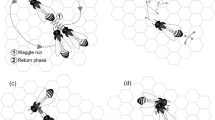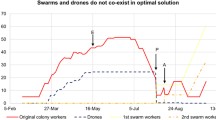Abstract
Nectar collection in the honey-bee is partitioned. Foragers collect nectar and take it to the nest, where they transfer it to receiver bees who then store it in cells. Because nectar is a fluctuating and unpredictable resource, changes in worker allocation are required to balance the work capacities of foragers and receivers so that the resource is exploited efficiently. Honey bee colonies use a complex system of signals and other feedback mechanisms to coordinate the relative and total work capacities of the two groups of workers involved. We present a functional evaluation of each of the component mechanisms used by honey bees – waggle dance, tremble dance, stop signal, shaking signal and abandonment – and analyse how their interplay leads to group-level regulation. We contrast the actual regulatory system of the honey bee with theory. The tremble dance conforms to predicted best use of information, where the group in excess applies negative feedback to itself and positive feedback to the group in shortage, but this is not true of the waggle dance. Reasons for this and other discrepancies are discussed. We also suggest reasons why honey bees use a combination of recruitment plus abandonment and not switching between subtasks, which is another mechanism for balancing the work capacities of foragers and receivers. We propose that the waggle and tremble dances are the primary regulation mechanisms, and that the stop and shaking signals are secondary mechanisms, which fine-tune the system. Fine-tuning is needed because of the inherent unreliability of the cues, queueing delays, which foragers use to make recruitment decisions.
Similar content being viewed by others
Author information
Authors and Affiliations
Additional information
Received: 15 December 1998 / Received in revised form: 6 March 1999 / Accepted: 12 March 1999
Rights and permissions
About this article
Cite this article
Anderson, C., Ratnieks, F. Worker allocation in insect societies: coordination of nectar foragers and nectar receivers in honey bee (Apis mellifera) colonies. Behav Ecol Sociobiol 46, 73–81 (1999). https://doi.org/10.1007/s002650050595
Issue Date:
DOI: https://doi.org/10.1007/s002650050595




